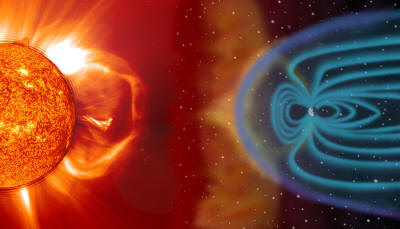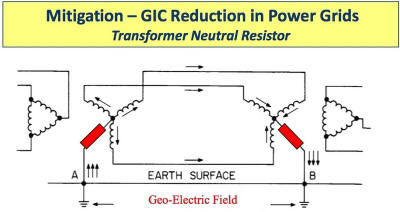|

by Brandon Keim
April 17, 2009
from
WiredScience Website
For scary speculation about the end
of civilization in 2012, people usually turn to followers of
cryptic Mayan prophecy, not scientists.
But thatís exactly what a group of
NASA-assembled researchers described in a chilling report issued
earlier this year on the destructive potential of solar storms.

Entitled "Severe
Space Weather Events - Understanding Societal and Economic Impacts,"
it describes the consequences of solar flares unleashing waves of
energy that could disrupt Earthís magnetic field, overwhelming
high-voltage transformers with vast electrical currents and
short-circuiting energy grids.
Such a catastrophe would cost the United
States "$1 trillion to $2 trillion in the first year," concluded the
panel, and "full recovery could take 4 to 10 years." That would, of
course, be just a fraction of global damages.
Good-bye, civilization.
Worse yet, the next period of intense solar activity is expected in
2012, and coincides with the presence of
an unusually large hole in Earthís
geomagnetic shield. But the report received relatively little
attention, perhaps because of 2012ís supernatural connotations.
Mayan astronomers supposedly predicted that 2012 would mark the
calamitous "birth of a new era."
Whether the Mayans were on to something, or this is all just a
chilling coincidence, wonít be known for several years.
But according to Lawrence Joseph,
author of "Apocalypse
2012 - A Scientific Investigation into Civilizationís End,"
"Iíve been following this topic for
almost five years, and it wasnít until the report came out that
this really began to freak me out."
Wired.com talked to Joseph:
Wired.com: Do you think itís coincidence that the
Mayans predicted apocalypse on
the exact date when astronomers say the sun will next reach a
period of maximum turbulence?
Lawrence Joseph: I have enormous respect for Mayan astronomers.
It disinclines me to dismiss this as a coincidence. But I
recommend people verify that the Mayans prophesied what people
say they did. I went to Guatemala and spent a week with two
Mayan shamans who spent 20 years talking to other shamans about
the prophecies. They confirmed that the Maya do see 2012 as a
great turning point. Not the end of the world, not the
great off-switch in the sky, but the birth of the fifth age.
Wired.com: Isnít a great off-switch in the sky exactly whatís
described in the report?
Joseph: The chair of the NASA workshop was Dan Baker at
the Laboratory for Atmospheric and Space Physics. Some of
his comments, and the comments he approved in the report, are
very strong about the potential connection between
coronal mass ejections and
power grids here on Earth. Thereís a direct relationship between
how technologically sophisticated a society is and how badly it
could be hurt. Thatís the meta-message of the report.
I had the good fortune last week to meet with John Kappenman
at
MetaTech. He took me
through a meticulous two-hour presentation about just how
vulnerable the power grid is, and how it becomes more vulnerable
as higher voltages are sent across it. He sees it as a big
antenna for space weather outbursts.
Wired.com: Why is it so vulnerable?
Joseph: Ultra-high voltage transformers become more finicky as
energy demands are greater. Around 50 percent already canít
handle the current theyíre designed for. A little extra current
coming in at odd times can slip them over the edge.
The ultra-high voltage transformers, the 500,000- and
700,000-kilovolt transformers, are particularly vulnerable. The
United States uses more of these than anyone else. China is
trying to implement some million-kilovolt transformers, but Iím
not sure theyíre online yet.
Kappenman also points out that when the transformers blow,
they canít be fixed in the field. They often canít be fixed
at all. Right now thereís a one- to three-year lag time between
placing an order and getting a new one.
According to Kappenman, thereís an as-yet-untested plan for
inserting ground resistors into the power grid. It makes the
handling a little more complicated, but apparently isnít
anything the operators canít handle. Iím not sure heíd say these
could be in place by 2012, as itís difficult to establish
standards, and utilities are generally regulated on a
state-by-state basis.
Youíd have quite a legal thicket.
But it still might be possible to get some measure of protection
in by the next solar climax.
Wired.com: Why canít we just shut down the grid when we see a
storm coming, and start it up again afterwards?
Joseph: Power grid operators now rely on
one satellite called ACE, which
sits about a million miles out from Earth in whatís called the
gravity well, the balancing point between sun and earth. It was
designed to run for five years. Itís 11 years old, is losing
steam, and there are no plans to replace it.
ACE provides about 15 to 45 minutes of heads-up to power plant
operators if somethingís coming in. They can shunt loads, or
shut different parts of the grid. But to just shut the grid off
and restart it is a $10 billion proposition, and there is lots
of resistance to doing so. Many times these storms hit at the
north pole, and donít move south far enough to hit us. Itís a
difficult call to make, and false alarms really piss people off.
Lots of money is lost and damage incurred.
But in Kappenmanís view, and in lots
of others, this time burnt could really mean burnt.
Wired.com: Do you live your life differently now?
Joseph: Iíve been following this topic for almost five years. It
wasnít until the report came out that it began to freak me out.
Up until this point, I firmly believed that the possibility of
2012 being catastrophic in some way was worth investigating. The
report made it a little too real. That document canít be
ignored. And it was even written before the
THEMIS satellite discovered a gigantic
hole in Earthís magnetic shield. Ten or twenty times
more particles are coming through this crack than expected. And
astronomers predict that the way the sunís polarity will flip in
2012 will make it point exactly the way we donít want it to in
terms of evading Earthís magnetic field.
Itís an astonishingly bad set of
coincidences.
Wired.com: If Barack Obama said, "Letsí prepare," and there
werenít any bureaucratic hurdles, could we still be ready in
time?
Joseph: I believe so. Iíd ask the President to slipstream behind
stimulus package funds already appropriated for smart grids,
which are supposed to improve grid efficiency and help transfer
high energies at peak times. Thereís a framework there. Working
within that, you could carve out some money for the ground
resistors program, if those tests work, and have the initial
momentum for cutting through the red tape. Itíd be a place to
start.
Wired.com talked to John
Kappenman, CEO of electromagnetic damage consulting company
MetaTech, about the possibility of geomagnetic apocalypse ó and how
to stop it.
Wired.com: Whatís the problem?
John Kappenman: Weíve got a big, interconnected grid that spans
across the country. Over the years, higher and higher operating
voltages have been added to it. This has escalated our
vulnerability to geomagnetic storms. These are not a new thing.
Theyíve probably been occurring for as long as the sun has been
around.
Itís just that weíve been unknowingly building an
infrastructure thatís acting more and more like an antenna for
geomagnetic storms.

Wired.com: What do you mean by
antenna?
Kappenman: Large currents circulate in the network, coming up
from the earth through ground connections at large transformers.
We need these for safety reasons, but ground connections provide
entry paths for charges that could disrupt the grid.
Wired.com: Whatís your solution?
Kappenman: What weíre proposing is to add some fairly small and
inexpensive
resistors in the transformersí ground connections.
The addition of that little bit of resistance would
significantly reduce the amount of the geomagnetically induced
currents that flow into the grid.
Wired.com: What does it look like?
Kappenman: In its simplest form, itís something that might be
made out of cast iron or stainless steel, about the size of a
washing machine.
Wired.com: How much would it cost?
Kappenman: Weíre still at the conceptual design phase, but we
think itís do-able for $40,000 or less per resistor. Thatís less
than what you pay for insurance for a transformer.
Wired.com: And less than what youíd willingly pay for
insurance on civilization.
Kappenman: If youíre talking about the United States, there are
about 5,000 transformers to consider this for. The
Electromagnetic Pulse Commission
recommended it in a report they sent to Congress last year.
Weíre talking about $150 million or so. Itís pretty small in the
grand scheme of things.
Big power lines and substations can withstand all the other
known environmental challenges. The problem with geomagnetic
storms is that we never really understood them as a
vulnerability, and had a design code that took them into
account.
Wired.com: Can it be done in time?
Kappenman: Iím not in the camp thatís certain a big storm will
occur in 2012. But given time, a big storm is certain to occur
in the future. They have in the past, and they will again.
Theyíre about one-in-400-year events. That doesnít mean it will
be 2012. Itís just as likely that it could occur next week.
|


